#PCB Power Management
Explore tagged Tumblr posts
Text
youtube
Würth Elektronik: REDCUBE Terminals (Innovative High Power Contacts)
https://www.futureelectronics.com/resources/featured-products/wurth-elektronik-redcube-terminals . REDCUBE terminals are the most reliable high-power contacts on the PCB level. Low contact resistance guarantees minimum self-heating. Four different designs cover all leading processing technologies and offer a wide range of applications. https://youtu.be/8EjH-SM1azE
#Wurth#REDCUBE Terminals#High Power Contacts#PCB Level#Low Contact Resistance#Minimum Self-Heating#Future Electronics#Wurth Elektronik#PCB Power Management#Youtube
0 notes
Text
Star product: A solid fortress guarding smart water meters—YMIN 3.8V supercapacitor
Market Prospects for Smart Water Meters

Smart water meters are in high demand due to urbanization, improved living standards, and environmental awareness. The market is growing, especially with the upgrade of water supply facilities and new residential projects.
YMIN 3.8V Supercapacitor Function
YMIN 3.8V supercapacitors, paired with lithium-thionyl chloride batteries, ensure smart water meters perform data storage, measurements, and remote communication efficiently by providing high-power output and preventing battery passivation.

Advantages
Low Temperature Resistance: Operates stably from -40°C to +70°C.
Long Lifespan: Reduces maintenance costs due to non-chemical reaction energy storage.
Ultra-Low Self-Discharge: Minimizes static power consumption.
Maintenance-Free: Combines with batteries for optimal performance.
Conclusion
YMIN 3.8V supercapacitors offer reliable, long-lasting energy solutions for smart water meters, ensuring stable operation in various environments.
#smarthome#smartmeter#meter#electricmeter#Electronic equipment#capacitors#electronic#power management#PCB design#games#critical role
0 notes
Text
Looking Back
Today, 26 March 2025, is the tenth anniversary of the first time I put power to a Z80 microprocessor in a breadboard and watched it blink some LEDs.

Within a few weeks that Z80 would be completely surrounded by other chips and hundreds of wires to form my first functioning homebrew computer.

Another week and I was already removing a 68000 from a (presumed) dead motherboard, with grand ideas of moving up to the 16-bit era (but absolutely no understanding of what that would entail)

It would be another two years before the first time I put that 68000 in a breadboard and successfully used it to blink an LED.

By the time another year had rolled around that 68000 was living on a soldered breadboard and for the first time on one of my projects, it was running real software — EhBASIC.

Always looking to more challenging projects, while I was building with a 68000, I was already reading through the manual for the 68030 trying to understand how to build with a proper 32-bit microprocessor. Just one more year and I had that 68030 on a wire wrap board, blinking an LED.

The next year I was doing the most ridiculous thing I could think of — free-running a Pentium CPU on a wire wrap breadboard to blink an LED. Because I could.

By the end of the next year that 68030 had moved from its wire wrap board onto a proper printed circuit board — my first ever 4-layer PCB.

The next year saw the towering expansion of the 68030 build, adding new peripherals and functionality.

Another year and I had an all-new 68030 build on a Micro-ATX form-factor motherboard developed in just a couple months ahead of VCF Southwest 2023.

The next year I focused on developing software for my existing 68030 board stack, rather than building something new from scratch. I succeeded in developing a minimal multi-user kernel to run four instances of BASIC simultaneously.
All along in between working on these projects I have done component-level repairs on various computers, developed expansion cards for the Mac SE, built PCs both new and old, burned out hard, developed some smaller homebrew computers, had a lot of false starts, failed projects, and abandoned projects, and completed some massive projects in my day job.
Looking back at everything I've worked on over these past 10 years I am absolutely amazed at how far I have come and what I have been able to accomplish. Much of it I still don't understand how I managed to actually pull it off, and I'm not entirely sure I could duplicate my successes.
Here's to the next ten years
#homebrew computing#homebrew computer#retro computing#retrocomputing#ten years#learning new things#zilog z80#motorola 68k
81 notes
·
View notes
Text
finally!! finished the guitar pedal my dad got the kit for like a year and a half ago

i redesigned it from scratch because the construction of the original clone was annoying and i think it’s dumb that guitar pedals sometimes use reverse-polarity power and you’re just supposed to guess, so this one takes either polarity through the same jack.


photographic evidence of how this distortion pedal works! based on the Proco RAT of 70s fame, essentially we just clip the signal peaks to introduce other frequencies, which make up the distortion we hear. the FFT on my scope didn’t show much, but either i didn’t tune it right or the instrumentation is just limited here, because we can see pretty clearly the flattened peaks on the processed signal (2, 3) compared to the input (1).



i learned some things about design for manufacturing (DFM) from this project, not just from the original clone board but also from shortcomings of my own design (it turns out that’s a LOT of wires to manage in that small space). if i did it over, i’d put the pins on a 0.1” pitch grid across the board, probably use larger components, and take more care in choosing the shape of the PCB to fit the enclosure around all the hardware. I might even have split it up into a few tiny boards! just for kicks. i also probably would have soldered wires onto the kick switch at an angle, so that they’re not stressed or bent on their way to their final configurations.



the light pipe in particular was a challenge because it turned out the cap on the pipe was small enough that it would slide all the way through the hole meant for a THT LED. I could have fixed this with a washer if I had one, but I eventually hot glued a nut to the cap and let it be.

big thanks to my friends and partners including @thinkpadt530 who helped me with this! i learned a lot from them all, and definitely would not have finished without them. <3
17 notes
·
View notes
Text
Hell is terms like ASIC, FPGA, and PPU
I haven't been doing any public updates on this for a bit, but I am still working on this bizarre rabbit hole quest of designing my own (probably) 16-bit game console. The controller is maybe done now, on a design level. Like I have parts for everything sourced and a layout for the internal PCB. I don't have a fully tested working prototype yet because I am in the middle of a huge financial crisis and don't have the cash laying around to send out to have boards printed and start rapidly iterating design on the 3D printed bits (housing the scroll wheel is going to be a little tricky). I should really spend my creative energy focusing on software development for a nice little demo ROM (or like, short term projects to earn money I desperately need) but my brain's kinda stuck in circuitry gear so I'm thinking more about what's going into the actual console itself. This may get techie.
So... in the broadest sense, and I think I've mentioned this before, I want to make this a 16-bit system (which is a term with a pretty murky definition), maybe 32-bit? And since I'm going to all this trouble I want to give my project here a little something extra the consoles from that era didn't have. And at the same time, I'd like to be able to act as a bridge for the sort of weirdos who are currently actively making new games for those systems to start working on this, on a level of "if you would do this on this console with this code, here's how you would do it on mine." This makes for a hell of a lot of research on my end, but trust me, it gets worse!
So let's talk about the main strengths of the 2D game consoles everyone knows and loves. Oh and just now while looking for some visual aids maybe I stumbled across this site, which is actually great as a sort of mid-level overview of all this stuff. Short version though-
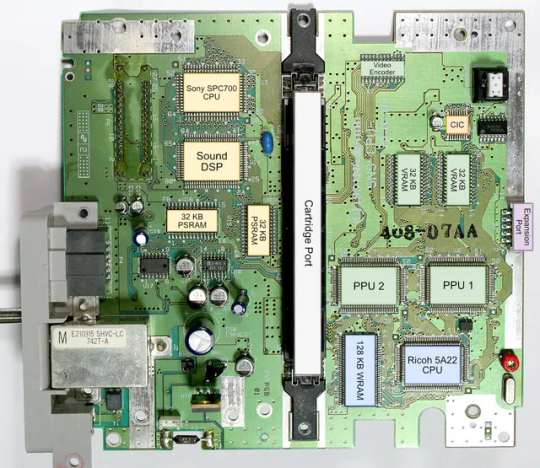
The SNES (or Super Famicom) does what it does by way of a combination of really going all in on direct memory access, and particularly having a dedicated setup for doing so between scanlines, coupled with a bunch of dedicated graphical modes specialized for different use cases, and you know, that you can switch between partway through drawing a screen. And of course the feature everyone knows and loves where you can have one polygon and do all sorts of fun things with it.
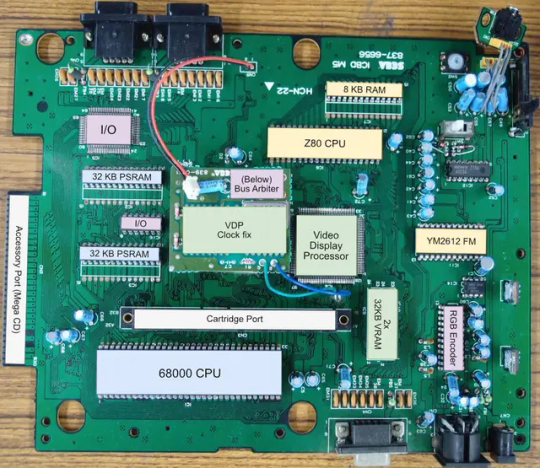
The Genesis (or Megadrive) has an actual proper 16-bit processor instead of this weird upgraded 6502 like the SNES had for a scrapped backwards compatibility plan. It also had this frankly wacky design where they just kinda took the guts out of a Sega Master System and had them off to the side as a segregated system whose only real job is managing the sound chip, one of those good good Yamaha synths with that real distinct sound... oh and they also actually did have a backwards compatibility deal that just kinda used the audio side to emulate an SMS, basically.
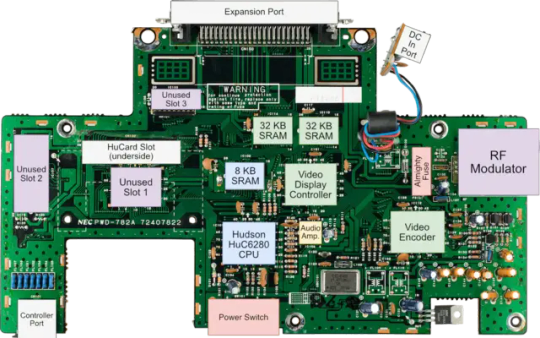
The TurboGrafix-16 (or PC Engine) really just kinda went all-in on making its own custom CPU from scratch which...we'll get to that, and otherwise uh... it had some interesting stuff going on sound wise? I feel like the main thing it had going was getting in on CDs early but I'm not messing with optical drives and they're no longer a really great storage option anyway.
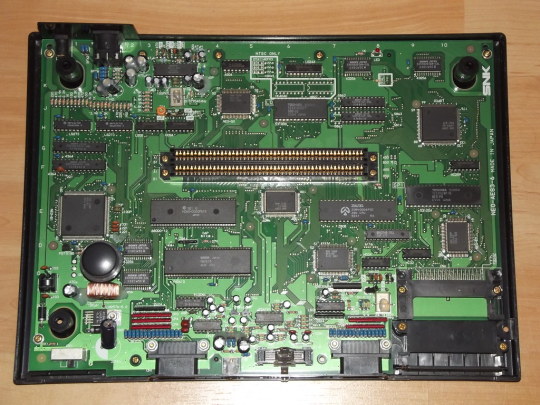
Then there's the Neo Geo... where what's going on under the good is just kind of A LOT. I don't have the same handy analysis ready to go on this one, but my understanding is it didn't really go in for a lot of nice streamlining tricks and just kinda powered through. Like it has no separation of background layers and sprites. It's just all sprites. Shove those raw numbers.
So what's the best of all worlds option here? I'd like to go with one of them nice speedy Motorolla processors. The 68000 the Genesis used is no longer manufactured though. The closest still-in-production equivalent would be the 68SEC000 family. Seems like they go for about $15 a pop, have a full 32-bit bus, low voltage, some support clock speeds like... three times what the Genesis did. It's overkill, but should remove any concerns I have about having a way higher resolution than the systems I'm jumping off from. I can also easily throw in some beefy RAM chips where I need.
I was also planning to just directly replicate the Genesis sound setup, weird as it is, but hit the slight hiccup that the Z80 was JUST discontinued, like a month or two ago. Pretty sure someone already has a clone of it, might use that.
Here's where everything comes to a screeching halt though. While the makers of all these systems were making contracts for custom processors to add a couple extra features in that I should be able to work around by just using newer descendant chips that have that built in, there really just is no off the shelf PPU that I'm aware of. EVERYONE back in the day had some custom ASIC (application-specific integrated circuit) chip made to assemble every frame of video before throwing it at the TV. Especially the SNES, with all its modes changing the logic there and the HDMA getting all up in those mode 7 effects. Which are again, something I definitely want to replicate here.
So one option here is... I design and order my own ASIC chips. I can probably just fit the entire system in one even? This however comes with two big problems. It's pricy. Real pricy. Don't think it's really practical if I'm not ordering in bulk and this is a project I assume has a really niche audience. Also, I mean, if I'm custom ordering a chip, I can't really rationalize having stuff I could cram in there for free sitting outside as separate costly chips, and hell, if it's all gonna be in one package I'm no longer making this an educational electronics kit/console, so I may as well just emulate the whole thing on like a raspberry pi for a tenth of the cost or something.
The other option is... I commit to even more work, and find a way to reverse engineer all the functionality I want out with some big array of custom ROMs and placeholder RAM and just kinda have my own multi-chip homebrew co-processors? Still PROBABLY cheaper than the ASIC solution and I guess not really making more research work for myself. It's just going to make for a bigger/more crowded motherboard or something.
Oh and I'm now looking at a 5V processor and making controllers compatible with a 10V system so I need to double check that all the components in those don't really care that much and maybe adjust things.
And then there's also FPGAs (field programmable gate arrays). Even more expensive than an ASIC, but the advantage is it's sort of a chip emulator and you can reflash it with something else. So if you're specifically in the MiSTer scene, I just host a file somewhere and you make the one you already have pretend to be this system. So... good news for those people but I still need to actually build something here.
So... yeah that's where all this stands right now. I admit I'm in way way over my head, but I should get somewhere eventually?
11 notes
·
View notes
Text
LG EBR85624963 Refrigerator PCB Main Control Board (PCB Assembly) HnKParts
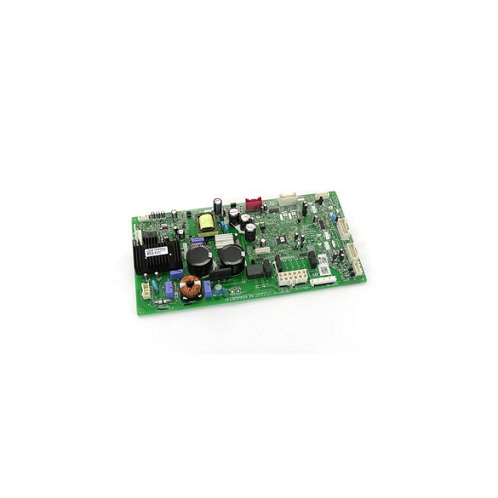
The LG EBR85624963 Refrigerator PCB Main Control Board controls the signals from the sensors, regulates temperature, and manages the work of the compressor and other components. Through continuous data processing from different sections of the refrigerator, it is able to maintain efficiency in its usage of power to ensure it operates at its better level. The advantages of this PCB include increased durability, better heat control and power control.
If you're looking for a reliable replacement, the LGE Refrigerator PCB Main Control Board (PCB Assembly) is an excellent choice for the smooth operation of your home appliance
2 notes
·
View notes
Text
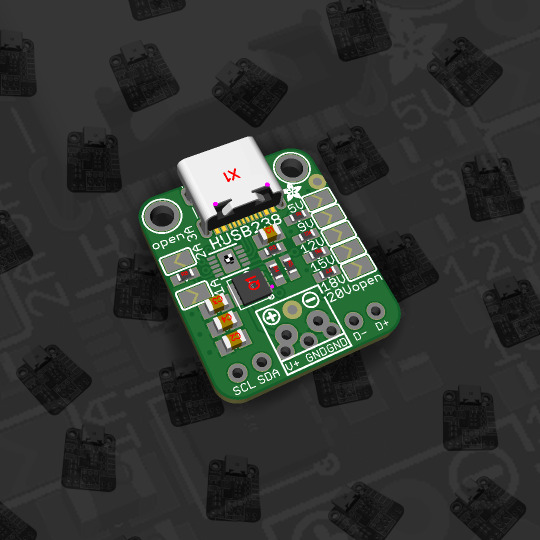
PCB of the day! HUSB238 USB PD Sink Breakout 🔌🔋💡
USB C has a nifty power management system where, by default, you can get a classic 5V at 1A power out from a power supply or port, but with some fancy twiddling, you can request higher voltages and currents. We've always wanted a simple breakout that could get you a range of voltages using just jumper pads, but we only had a little luck with IP2721. Then we found this chip - the HUSB238 https://en.hynetek.com/pdsink.html - used in a USB-to-DC cable, which seems perfect! It can do 5V to 20V with just a resistor setting and set the current. There's also an I2C interface that can be used to set them if the settings are persistent - we'll have to try it out. There's a library here if you want to see what the registers are like https://github.com/ltyridium/HUSB238-lib. Here's our draft for a breakout design.
#adafruit#electronics#pcb#opensource#opensourcehardware#pcboftheday#husb238#usbc#usbtodc#i2c#breakoutboard#powermanagement#usbpd#voltagecontrol#currentsetting#electricalengineering#hardwaredesign#circuitboard#technology#innovation
26 notes
·
View notes
Text
Good News - April 22-28
Like these weekly compilations? Support me on Ko-fi! Also, if you tip me on here or Ko-fi, at the end of the month I'll send you a link to all of the articles I found but didn't use each week - almost double the content! (I'm new to taking tips on here; if it doesn't show me your username or if you have DM's turned off, please send me a screenshot of your payment)
1. Millions Of Maggots Donated To Charity In Honour Of The Maggot King

“[Blizzard Entertainment] donated millions of maggots to Tiggywinkles UK, a leading wildlife hospital, […] in honor of Duriel, the Maggot King, a notorious character in the Diablo series. […] This significant contribution is expected to feed the patients at Tiggywinkles for two years.”
2. New circuit boards can be repeatedly recycled
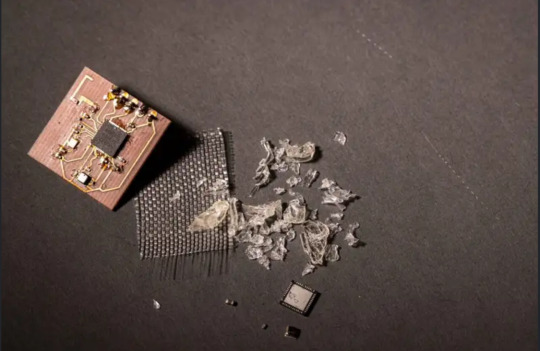
“A team led by researchers at the University of Washington developed a new PCB that performs on par with traditional materials and can be recycled repeatedly with negligible material loss. Researchers used a solvent that transforms a type of vitrimer—a cutting-edge class of sustainable polymers—to a jelly-like substance without damaging it, allowing the solid components to be plucked out for reuse or recycling.”
3. How a Cloned Ferret Inspired a DNA Bank for Endangered Species

“This black-footed ferret (Mustela nigripes) [is] the first endangered species in the U.S. to ever be successfully cloned […] from [a] cryogenically preserved cell line, obtained from a ferret named Willa, who lived in Wyoming in the 1980s. [… T]he FWS [is now] on a major project to cryogenically store tissue from every endangered species in the U.S., [… as] “an insurance policy against future loss of biodiversity in the wild.””
4. Maine Signs Trans And Abortion Sanctuary Bill Into Law, Despite Violent Threats

“[The new law] states that criminal and civil actions against providers and patients are not enforceable if the provision or access to that care occurred within Maine’s borders, asserting jurisdiction over those matters. It bars cooperation with out-of-state subpoenas and arrest warrants for gender-affirming care and abortion that happen within the state.”
5. $70M for Fish Passage Projects Address Climate Resilience, Strengthen Local Economies

“The Department of the Interior today announced more than $70 million […] that will improve fish passage around […] barriers fragmenting the nation’s rivers and streams [… as an] “investment to restore our nation’s rivers and streams, safeguard endangered fish species, protect Indigenous subsistence practices and provide communities with increased opportunities for outdoor recreation and economic growth,” said Secretary Deb Haaland.”
6. A Golden Age of Renewables Is Beginning, and California Is Leading the Way

“California—the fifth-largest economy in the world—has experienced a record-breaking string of days in which the combined generation of wind, geothermal, hydroelectric and solar electricity has exceeded demand on the main electricity grid for anywhere from 15 minutes to 9.25 hours per day.”
7. Collaborative conservation efforts keep lake sturgeon off the endangered species list

“The Service’s 12-month finding [that these sturgeon are not endangered] shows ongoing management efforts, such as fish stocking, have contributed to the conservation and resiliency of the species. “Today’s announcement shows the power of collaborative conservation and the impact it can have for species like the lake sturgeon,” said Midwest Regional Director Will Meeks.”
8. French municipalities bordering Luxembourg to offer free transport to commuters
“Luxembourg is the only country in the world to offer entirely free public transport. […S]ix French communities located near the border and many of whose residents work in Luxembourg have decided to band together and also offer a free shuttle for daily workers. […] Last year, governments in the two countries said they would work to increase train services to run every 10 minutes between Metz and Luxembourg City by 2030. There’s also a plan to extend Luxembourg City’s tram service to reach all the way to the border – a trip that would take only 30 minutes when ready.”
9. Solar is about to get a lot more affordable for low-income households

“The EPA granted 49 state and territory awards totaling $5.5 billion, six tribal awards worth more than $500 million, and five multistate awards amounting to $1 billion. Together, the awards cover all 50 states, Puerto Rico, and the District of Columbia. All of the funding is dedicated to low-income and disadvantaged households.”
10. Amsterdam will cover cost of changing one's gender on documents

“[T]he city’s residents will be able to change the gender on their birth certificate and Basic Registration of Persons (BRP) free of charge. [… T]he local government will also reimburse (part of) the costs of a new passport, identity card or driver's license.”
April 15-21 news here | (all credit for images and written material can be found at the source linked; I don’t claim credit for anything but curating.)
#good news#hopepunk#bugs#tw bugs#diablo#wildlife#technology#recycling#ferret#cloning#dna#endangered species#trans#abortion rights#abortion#law#transgender#fish#renewableenergy#solar#geothermal#electricity#sturgeon#conservation#nature#france#public transit#low income#lgbtq#lgbtqia
6 notes
·
View notes
Text
Understanding Circuit Board Electronic Components: A Comprehensive Guide
In today's digital world, electronic devices have become an essential part of our daily lives. But what makes these devices tick? At the heart of every electronic device lies a circuit board—a masterpiece of tiny electronic components working together to perform complex tasks. In this article, we’ll dive deep into the fascinating world of circuit board electronic components, exploring each element’s role and how they contribute to the overall functionality of the device.
What is a Circuit Board?
A circuit board, often referred to as a PCB (Printed Circuit Board), is a flat board used to mechanically support and electrically connect various electronic components. These components work in unison to perform a specific task. Think of the circuit board as the skeleton and nervous system of an electronic device—it holds everything together and allows communication between parts.
Types of Circuit Boards
Single-sided PCB: Has one layer of conducting material.
Double-sided PCB: Contains two layers for components and connections.
Multi-layer PCB: Complex boards with multiple layers for advanced applications.
The Role of Electronic Components on a Circuit Board
Every electronic device you interact with is powered by a carefully designed circuit board filled with various components. These components might be tiny, but each one has a critical role in the operation of the device. Here's a breakdown of the most important electronic components you’ll find on a typical circuit board.
1. Resistors
Resistors are fundamental components that control the flow of electrical current. They resist the flow of electrons, hence the name "resistor." Their primary function is to reduce current flow, adjust signal levels, and divide voltages in a circuit. Without resistors, circuits would allow too much current to flow, potentially damaging other components.
Types of Resistors
Fixed resistors: Have a set resistance value.
Variable resistors: Allow adjustment of the resistance.
2. Capacitors
Capacitors store and release electrical energy in a circuit. They are often compared to small rechargeable batteries that quickly charge and discharge. Capacitors help smooth out fluctuations in voltage, filter noise, and store energy for future use.
Common Uses of Capacitors
Energy storage
Signal filtering
Voltage stabilization
3. Inductors
Inductors are components that store energy in a magnetic field when electrical current flows through them. They resist changes in current and are typically used in circuits to filter signals, manage power, and store energy.
Applications of Inductors
Power supplies
Radio frequency circuits
Noise suppression in circuits
4. Diodes
A diode is like a one-way valve for electricity, allowing current to flow in only one direction. They are vital in circuits to prevent reverse currents, which can damage components.
Types of Diodes
Light-emitting diodes (LEDs): Produce light when current flows through.
Zener diodes: Regulate voltage within a circuit.
5. Transistors
The transistor is a versatile component used to amplify or switch electronic signals. In essence, transistors are like tiny switches that turn signals on and off rapidly, making them essential in modern electronics.
Types of Transistors
NPN transistors: Allow current flow when a small voltage is applied to the base.
PNP transistors: Conduct when the base is negatively charged.
How Circuit Board Components Work Together
In a circuit, each component has a specific role, and together they form a cohesive system. For example:
Capacitors and resistors may work together to filter signals or smooth out voltage fluctuations.
Transistors and diodes ensure that signals are amplified or directed properly.
Integrated circuits handle the complex tasks, processing data, and controlling the overall system.
Choosing the Right Components for Your Circuit Board
When designing or repairing a circuit board, choosing the correct components is crucial. Some factors to consider include:
Voltage requirements
Power consumption
Signal type and frequency
Physical size and compatibility
Conclusion
Circuit boards are an integral part of any electronic device. The various components on the board each play a specific role in ensuring the device functions as intended. Understanding these components, from resistors to integrated circuits, is essential for anyone working with electronics, whether you're designing a new system or troubleshooting an existing one.
2 notes
·
View notes
Text
Understanding the Functionality of Samsung Refrigerator PCB Main Assembly

Samsung refrigerators have become essential appliances in modern households, offering innovative features and advanced technologies to ensure food preservation and convenience. The (Printed Circuit Board) PCB Main Assembly serves as the brain of the refrigerator, coordinating various functions and ensuring optimal performance.
Components of the Refrigerator PCB Main Assembly
The Refrigerator PCB Main Assembly consists of several essential components, each playing a crucial role in the refrigerator's operation.
Microcontroller: It is the central processing unit (CPU) and the computer performs programmed instructions to coordinate communication between the components.
Sensors: The ambient parameters (temperature, humidity, door status) supply critical information for regulation.
Relays: You control the flow of electricity to the compressor, fan motors, and defrost heater.
Capacitors: It will help you store the electrical energy and help to regulate voltage, and guarantee that the PCB is operating reliably.
Resistors: Protect sensitive components from harm by limiting the flow of electricity across certain circuits.
Diodes: Allow current to flow exclusively in one direction to avoid reverse polarity and safeguard components from damage.
Connectors: Facilitate electrical connections between the PCB and other refrigerator components to ensure seamless integration.
Working Principle PCB Main Assembly
The PCB Main Assembly operates on a set of programmed instructions that determine its behavior depending on sensor input and user command. The micro controller continuously monitors sensor input such as the reading of the temperature from the refrigerator compartment, and freezer. The microcontroller controls the transition of the compressor on, or off or the speed of the fan and also the defrost cycles based on the sensor data as to how to keep the temperature and humidity at the optimal level. In addition to the other refrigerator components, for example, display panel and user interface, the PCB Main Assembly provides feedback and enables users’’ interaction. The PCB Main Assembly incorporates safety features of overload protection and temperature sensors to protect the refrigerator from damage and to protect the user.
Communication Protocols
Data can be communicated to other components through microcontrollers by communication protocols like UART (Universal Asynchronous Receiver Transmitter), SPI (Serial Peripheral Interface), and I2C (Inter Integrated Circuit).
UART is used to transfer real-time data from a microcontroller to external devices like display panels and temperature sensors.
There is a power of communication SPI and I2C for the communication of integrated circuits associated with the PCB Main Assembly for efficient data transfer and synchronization between components.
Troubleshooting and Maintenance
Common issues with the Samsung Refrigerator PCB Main Assembly include sensor failures, relay malfunctions, and power supply issues, which can affect the refrigerator's performance.
To solve PCB Main Assembly problems, we can use diagnostic methods, like running self-tests and checking the error code.
The assembly can stay longer depending on the main, such as cleaning dust and debris from the PCB and securing appropriate ventilation.
The PCB Main Assembly is an important component of the Samsung refrigerator systems since it organizes several functions to contribute to the overall efficiency of the refrigerator and food preservation. Fore-knowledge of the PCB Main Assembly and the way it is constructed can assist users in likely managing problems in their fridges.
2 notes
·
View notes
Text
Galena is back up and running after some light soldering. Had to rewrite the configuration for it because the broken wire turned out to actually be a snapped off pad, whoops.
Just moved that wire to another pad and carried on. Forgot to set my thumb-button backspace on the first go around and realized how extremely dependent I am on thumb-button backspace being a thing. I apparently lost track of the original configuration files but I use this every day so I just had to sit down and let muscle memory summon up the exact position of some of the unlabeled keys. If I forgot something clearly I don't use it that often.
I'll make a base for this and finish it up soon hopefully but I expect Galena will be an ongoing project, one thing I want to try and do is make a custom 2.4GHz dongle so that I can run it wireless without having to deal with bluetooth. At that point I'll probably have to make a PCB to handle power management circuitry and all the extra traces to run SPI/Serial/Whatever but that's future me problems.
The soldering iron I got online is Not Good, most concerning is the use of a PVC cable instead of the good heatproof rubber so I might end up getting rid of it but it's good enough for a quick fix and at least it's temperature controlled.
9 notes
·
View notes
Text

Cabal (カベール, Kabēru) is a 1988 arcade shooter video game originally developed by TAD Corporation and published in Japan by Taito, in North America by Fabtek and in Europe by Capcom. In the game, the player controls a commando, viewed from behind, trying to destroy various enemy military bases. The game was innovative for the era, but only a mild success in the arcades, and became better known for its various home conversions.
Cabal has one-player and two-player-simultaneous modes of gameplay. Each player assumes the role of an unnamed commando trying to destroy several enemy military bases. There are 5 stages with four screens each. The player starts with a stock of three lives and uses a gun with limitless ammunition and a fixed number of grenades to fend off enemy troops and attack the base. The commando is seen from behind and starts behind a protective wall which can be damaged and shattered by enemy fire. To stay alive, the player needs to avoid enemy bullets by running left or right, hiding behind cover, or using a dodge-roll. An enemy gauge at the bottom of the screen depletes as foes are destroyed and certain structures (which collapse rather than shatter) are brought down. When the enemy gauge is emptied, the level is successfully completed, all of the remaining buildings onscreen collapse, and the player progresses to the next stage. If a player is killed, he is immediately revived at the cost of one life or the game ends if they have no lives remaining. Boss fights, however, restart from the beginning if the only remaining player dies.
From time to time, power-ups are released from objects destroyed onscreen. Some power-ups give special weapons such as an extremely fast-firing machine gun or an automatic shotgun with a lower firing rate and larger area of effect. Others grant extra grenades or additional points.
The arcade cabinet is a standard upright cabinet. Each player uses a trackball to move their character from side to side and move the crosshairs about the screen. On later board revisions, a joystick was installed instead with an optional sub-PCB for use with a trackball. With a trackball, dodge-rolling is done by pushing the trackball to maximum speed.
Cabal was somewhat innovative in that it featured a 3D perspective in which the player character was situated in the foreground with an over-the-shoulder camera view, similar to modern third-person shooters. Players cannot move the character while firing (holding down the fire button gives players control of the aiming cursor), and when moving the character to avoid incoming bullets, the aiming cursor moves along in tandem. This creates the need for a careful balance between offensive and defensive tactics, separating Cabal from run-and-gun shooters which relied more on reflexes. Advanced gameplay involves destructible asset management in balancing dodging (which gets riskier as the number of enemy projectiles on screen increases) with the safer alternative of taking cover behind a protective but limited durability wall.
Cabal was ported to several home computers of the era, including the DOS computers, Amstrad CPC, Commodore 64, ZX Spectrum, Atari ST and Amiga. It was also ported to the Nintendo Entertainment System console by Rare. A version for the Atari Lynx was previewed and even slated to be published in April 1992, but it was never released by Fabtek.
When converting the game to the Nintendo Entertainment System, Rare were given a Cabal cabinet but did not have access to the game's source code, so they had to play the game over and over and redraw the graphics from memory. To accommodate the many layers and sprites of the arcade game, programmer Anthony Ball used a common coding trick: swapping sprites from left to right every other frame. This has the negative side effect of causing the sprites to flicker when they reach the console's limit of eight per line, but Ball, like many programmers of the era, found this an acceptable trade-off for including all the game's content, and in a 2016 interview he said he is happy with the quality of the conversion.
5 notes
·
View notes
Text
AliExpress rules, I am fully AliExpress pilled. I've bought a replacement Li-ion battery for my high end DAP which has extended its life; I've sourced replacement screws and switches for my guitars and even some Schaller locking strap hardware, I've found a modding kit for my old iPod for replacing the battery and swapping out the harddrive with a dual microSD card reader, and I've found all sorts of replacement capacitors and little fiddly bits to fix electronics I'd otherwise have to throw out. The majority of my guitar pedalboard is Joyo, MoskyAudio and Calin pedals I bought from AliExpress and they're all quality. I took a few of those pedals apart to see what they were like inside and it was all recognizable analog parts and pretty decent printed PCBs, the soldering was mediocre in spots but whatever, it doesn't matter. The power supply for my pedals is from AliExpress too and it's greatm The mini-PC I own which runs my Plex server was purchased from AliExpress and it's been running 24/7 for eleven months with no downtime. I've bought cheap cable management stuff from AliExpress that really helped me to organize and tidy my desk and working area. The one t-shirt I bought as a joke was actually a lot nicer than I was expecting, I can't speak to the other clothing, some of it does look rather crap. I've seriously considered buying one of those "Chibson" counterfeits and having it set up properly because it'd be nice to have a Les Paul, and no way in hell I'm paying $8,000 for a base model Gibson. I've found factory stores on there that do fully custom Latex fetish wear for affordable prices, retro emulation handheld consoles that are actually worth owning, passable Magic the Gathering proxies, all sorts of stuff. AliExpress is fucking great, you just gotta be careful and selective about what storefronts you're ordering from and be okay with waiting a month for things to arrive.
Temu and Wish fully suck though.
i hate you shein. i hate you wish. i hate you temu. i hate you aliexpress. i hate you fast fashion. i hate you consumerism. i hate you planned obsolescence. i hate you plastics.
83K notes
·
View notes
Text
Raj Cooling Systems to Unveil Largest-Ever Product Launch at Aakar Exhibition 2025
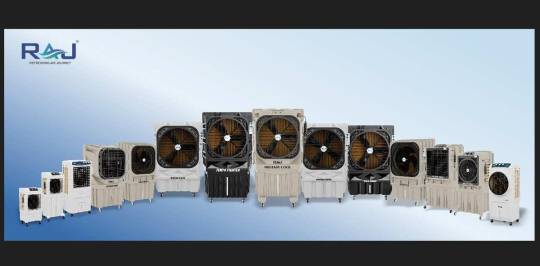
New Delhi, 26th June, 2025 – Raj Cooling Systems Pvt. Ltd., a leading name in the air cooling industry, is gearing up for its most ambitious showcase yet at the upcoming Aakar Exhibition 2025—India’s premier expo for the tent and décor segment. The event is scheduled to take place from August 3–6, 2025, at India Expo Mart, Greater Noida (Hall No. 9, Stall No. 903).
A Landmark Launch: Most Expansive Product Lineup Yet
This year marks a historic milestone for Raj Cooling Systems as it prepares to unveil its largest and most innovative product range to date. The lineup spans both domestic and commercial categories, with a strong focus on cutting-edge features, energy efficiency, and modern design tailored to evolving consumer and industry needs.
Revolutionizing Home Cooling: Two New Domestic Categories
At the heart of the launch are two brand-new categories of domestic air coolers, offering an extensive variety of tower, desert, commercial, and residential coolers. These models are engineered to deliver:
Superior cooling efficiency
Lower energy consumption
Stylish, space-saving designs ideal for modern interiors
Empowering Events: Next-Gen Tent Coolers
Raj Cooling Systems is also introducing a new line of next-generation tent coolers—specifically designed for large venues, outdoor events, and the tent décor industry. Key features include:
Heavy-duty performance
High-capacity water tanks
Durable construction
Optimized for high-traffic, high-temperature environments
These models offer powerful air delivery and efficient climate control, even in semi-open or open-air setups.
Smart Technology & User-Centric Design
Across the new lineup, Raj Cooling Systems has integrated a range of advanced features to enhance performance and user experience, including:
Touchscreen / PCB control panels
Automatic water level sensors
Elegant glass top designs
Premium aesthetics
These innovations reflect the company’s commitment to delivering intelligent, stylish, and high-performance cooling solutions for every application.
Sustainable Innovation: Launch of BLDC Fans
In line with its focus on sustainability, the company is also launching a new range of BLDC (Brushless DC) fans. These fans are designed to provide:
Ultra-efficient air circulation
Minimal power consumption
Quiet and reliable operation
This move highlights Raj Cooling Systems' growing emphasis on eco-friendly technologies and user-first design.
A Message from the Chairman
Mr. Kalpesh Ramoliya, Chairman & Managing Director, stated:
“Each new product reflects our unwavering commitment to enhance the quality of human life and make industrial growth easier. Every innovation is thoughtfully designed to deliver greater comfort, efficiency, and user satisfaction, underscoring our mission to make everyday living better through advanced, reliable, and future-ready cooling solutions.”
Invitation to Experience the Future of Cooling
With a showcase defined by scale, innovation, and vision, Raj Cooling Systems Pvt. Ltd. invites visitors, partners, and industry professionals to witness the future of smart, sustainable, and stylish cooling at the Aakar Exhibition 2025.
0 notes
Text
Global HVAC Duct-Cleaning Robots Market : Key Drivers, Significant Analysis And Future Scope
Global PCB Solid State Relays Market valued at USD X.X Billion in 2024 and is projected to reach USD X.X Billion by 2032, growing at a CAGR of X.X% from 2025 to 2032. Global PCB Solid State Relays Market: Significant Analysis The global PCB solid state relays market is experiencing robust growth driven by increasing adoption across diverse industries such as automotive, industrial automation, and consumer electronics. Advancements in semiconductor technology and the demand for reliable, compact, and energy-efficient switching solutions are key factors propelling market expansion. Projections indicate a steady CAGR over the next several years, fueled by rising investments in smart grid technologies and IoT integration. Additionally, the trend towards miniaturization and enhanced performance in electronic components further supports market momentum. Emerging applications in renewable energy and healthcare sectors offer new avenues for growth. Challenges related to high initial costs and thermal management are being addressed through innovation, enabling wider acceptance. Overall, the market outlook remains positive, with continuous improvements anticipated to drive adoption globally. Get the full PDF sample copy of the report: (Includes full table of contents, list of tables and figures, and graphs) @ https://www.verifiedmarketresearch.com/download-sample/?rid=368234&utm_source=Glob-VMR&utm_medium=261 Global PCB Solid State Relays Market Key Drivers Key drivers of the global PCB solid state relays market include the increasing need for efficient and durable switching devices in various electronic applications. The rise in automation and smart manufacturing processes has elevated demand for reliable relays that offer faster switching speeds and longer operational lifespans compared to traditional electromechanical relays. Additionally, growing awareness about energy conservation and the push for low-power consumption electronics encourage the use of solid state relays. The expanding automotive industry, with a focus on electric and autonomous vehicles, also fuels market growth. Moreover, the surge in consumer electronics requiring compact and silent operation components boosts demand. Continuous advancements in materials and circuit design further enhance performance, making PCB solid state relays an attractive choice across sectors. Global PCB Solid State Relays Market: Future Scope The future scope of the global PCB solid state relays market is promising, with substantial growth anticipated due to technological advancements and expanding applications. As industries increasingly adopt automation and digital solutions, the demand for compact, efficient, and reliable switching devices will grow significantly. Innovations in semiconductor materials and integration with smart technologies will enable improved relay performance and functionality. Additionally, emerging sectors such as renewable energy, electric vehicles, and healthcare instrumentation offer new growth opportunities. The ongoing trend toward miniaturization and multifunctional devices will further drive market expansion. Regional developments, particularly in Asia Pacific, will play a crucial role in shaping the market landscape. Overall, the future outlook suggests strong growth supported by increasing investments and evolving technological requirements. Refractive Optical Element Market Regional Analysis The Asia Pacific region holds a pivotal position in the refractive optical element market due to rapid industrialization and technological advancements. Growing demand from sectors such as telecommunications, consumer electronics, and healthcare fuels regional market growth. Countries in this region are investing heavily in research and development, improving manufacturing capabilities and adopting advanced materials. Increasing applications in augmented reality, virtual reality, and laser systems contribute to rising market opportunities. Additionally, expanding
infrastructure and government support for high-tech industries create a favorable environment for market expansion. The region’s cost-effective manufacturing and skilled workforce further attract global players to establish production hubs. These factors collectively drive significant growth in the Asia Pacific refractive optical element market, positioning it as a key contributor to the global industry. Download Full PDF Sample Copy of PCB Solid State Relays Market Report @ https://www.verifiedmarketresearch.com/download-sample/?rid=368234&utm_source=Glob-VMR&utm_medium=261 Key Competitors in the PCB Solid State Relays Market These companies are renowned for their broad product offerings, sophisticated technologies, strategic efforts, and robust market presence. Each competitor's primary advantages, market share, current events, and competitive tactics—such as collaborations, mergers, acquisitions, and the introduction of new products—are highlighted in the study. Omron TE Connectivity Sensata Technologies Celduc Relais Siemens ABB Rockwell Automation. Get Discount On The Purchase Of This Report @ https://www.verifiedmarketresearch.com/ask-for-discount/?rid=368234&utm_source=Glob-VMR&utm_medium=261 PCB Solid State Relays Market Trends Insights PCB Solid State Relays Market Trend Insights offers a thorough examination of the market's current and developing trends, providing insightful data-driven viewpoints to assist companies in making wise decisions. This study explores the major consumer trends, market forces, and technology developments influencing the sector. By Specifications By Load Type By Application By Geography • North America• Europe• Asia Pacific• Latin America• Middle East and Africa For More Information or Query, Visit @ https://www.verifiedmarketresearch.com/product/pcb-solid-state-relays-market/ Detailed TOC of PCB Solid State Relays Market Research Report, 2026-2032 1. Introduction of the PCB Solid State Relays Market Overview of the Market Scope of Report Assumptions 2. Executive Summary 3. Research Methodology of Verified Market Reports Data Mining Validation Primary Interviews List of Data Sources 4. PCB Solid State Relays Market Outlook Overview Market Dynamics Drivers Restraints Opportunities Porters Five Force Model Value Chain Analysis 5. PCB Solid State Relays Market, By Geography North America Europe Asia Pacific Latin America Rest of the World 6. PCB Solid State Relays Market Competitive Landscape Overview Company Market Ranking Key Development Strategies 7. Company Profiles 8. Appendix About Us: Verified Market Research®Verified Market Research® is a leading Global Research and Consulting firm that has been providing advanced analytical research solutions, custom consulting and in-depth data analysis for 10+ years to individuals and companies alike that are looking for accurate, reliable and up to date research data and technical consulting. We offer insights into strategic and growth analyses, Data necessary to achieve corporate goals and help make critical revenue decisions.Our research studies help our clients make superior data-driven decisions, understand market forecast, capitalize on future opportunities and optimize efficiency by working as their partner to deliver accurate and valuable information. The industries we cover span over a large spectrum including Technology, Chemicals, Manufacturing, Energy, Food and Beverages, Automotive, Robotics, Packaging, Construction, Mining & Gas. Etc.Having serviced over 5000+ clients, we have provided reliable market research services to more than 100 Global Fortune 500 companies such as Amazon, Dell, IBM, Shell, Exxon Mobil, General Electric, Siemens, Microsoft, Sony and Hitachi. We have co-consulted with some of the world's leading consulting firms like McKinsey & Company, Boston Consulting Group, Bain and Company for custom research and consulting projects for businesses worldwide. Contact us:Mr. Edwyne FernandesVerified Market Research®US:
+1 (650)-781-4080UK: +44 (753)-715-0008APAC: +61 (488)-85-9400US Toll-Free: +1 (800)-782-1768Email: [email protected]:- https://www.verifiedmarketresearch.com/ Global Gardening Equipment Market
0 notes
Text
Optimising EMI Management in PCB Design: Best Practices for Reliable Performance

Electromagnetic interference (EMI) is a critical concern in modern electronics design. As devices become faster, more compact, and more interconnected, effective EMI management in PCB (Printed Circuit Board) design is essential to ensure product reliability, compliance with regulatory standards, and optimal performance.
This article explores the causes of EMI in PCB design, its effects, and proven strategies to optimise EMI management from the early design stages.
What Is EMI in PCB Design?
EMI refers to unwanted electromagnetic energy that disrupts the normal operation of an electronic circuit. In PCB design, EMI can originate from internal sources (such as high-speed digital signals, switching power supplies) or external sources (such as RF transmitters or nearby electronics).
Common issues caused by EMI include:
Signal integrity degradation
Increased error rates in data transmission
Interference with other devices
Product failure or malfunction
Causes of EMI in PCBs
Understanding the sources of EMI is the first step toward mitigation. Key causes include:
Poor grounding and return paths
High-speed signal transitions
Unshielded components and cables
Inadequate trace layout and spacing
Improper power distribution design
Strategies for Optimising EMI Management
1. Implement a Solid Ground Plane
A continuous ground plane minimizes impedance and provides an effective return path for high-frequency signals. Avoid splitting the ground plane, as this can create unwanted loops that radiate EMI.
2. Use Controlled Impedance Traces
High-speed signals should be routed using controlled impedance techniques. Differential pairs and matched trace lengths help reduce signal reflection and crosstalk.
3. Minimise Loop Areas
The loop area between a signal and its return path should be kept as small as possible. Larger loops act like antennas, increasing the potential for EMI emission.
4. Apply Proper Decoupling
Use decoupling capacitors close to power pins to suppress noise and stabilise voltage levels. Select capacitors with the right values and low equivalent series resistance (ESR).
5. Shielding and Filtering
Shield critical sections of the PCB with metal enclosures or ground planes. Use ferrite beads and EMI filters at key entry/exit points to block high-frequency noise.
6. Route Signals Thoughtfully
Keep high-speed traces short and direct.
Avoid 90-degree trace angles, as they increase EMI emission.
Separate analog and digital signals and isolate noisy components.
7. Use Stack-Up Optimisation
A well-planned multilayer PCB stack-up can improve EMI performance by sandwiching signal layers between ground or power planes, reducing radiated emissions.
EMI Testing and Compliance
Even with careful design, testing is essential. Conduct pre-compliance testing during prototyping using EMI test equipment or services. Ensure your product complies with standards like:
FCC (USA)
CISPR (Europe/International)
MIL-STD-461 (Military equipment)
0 notes